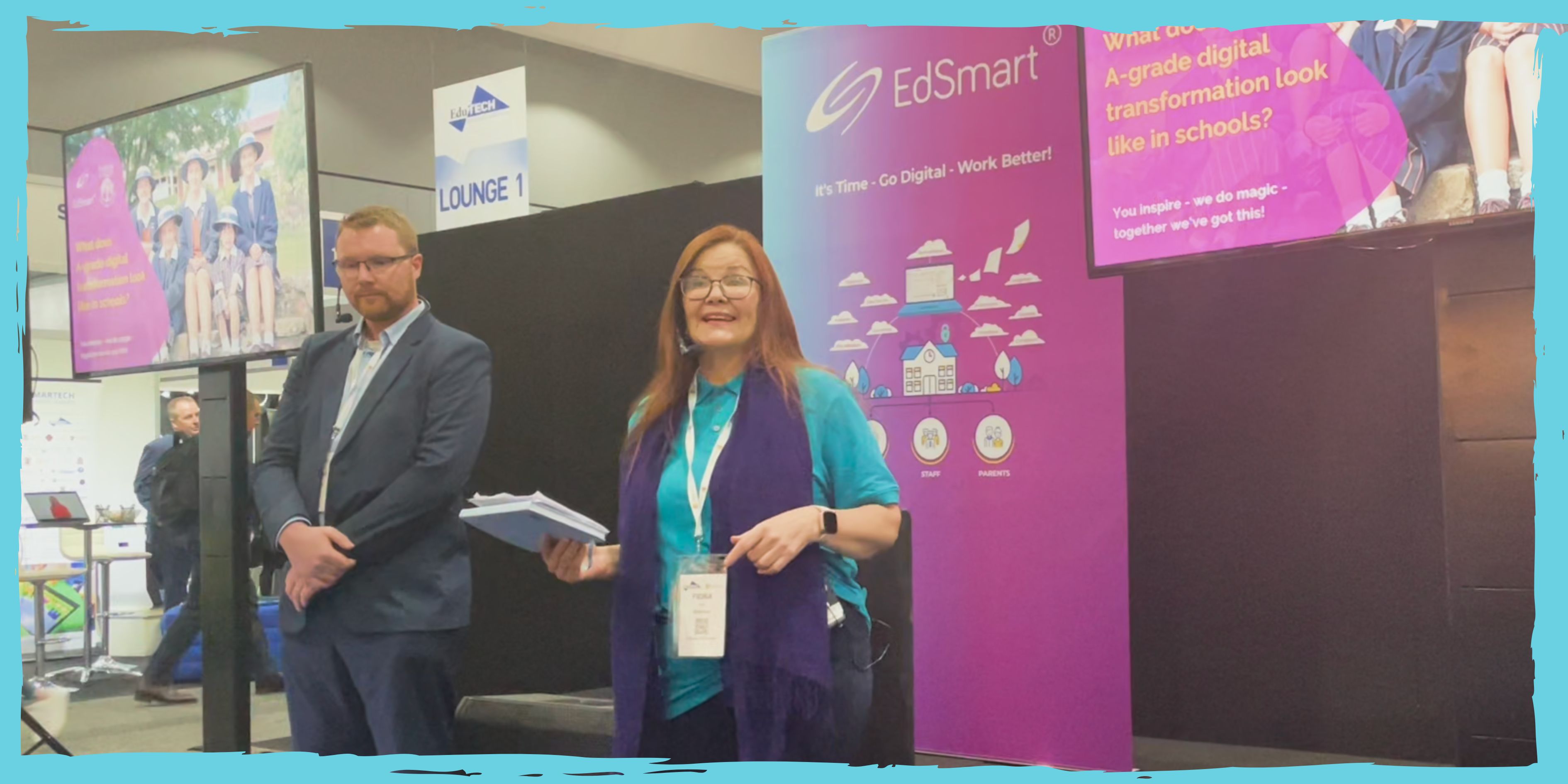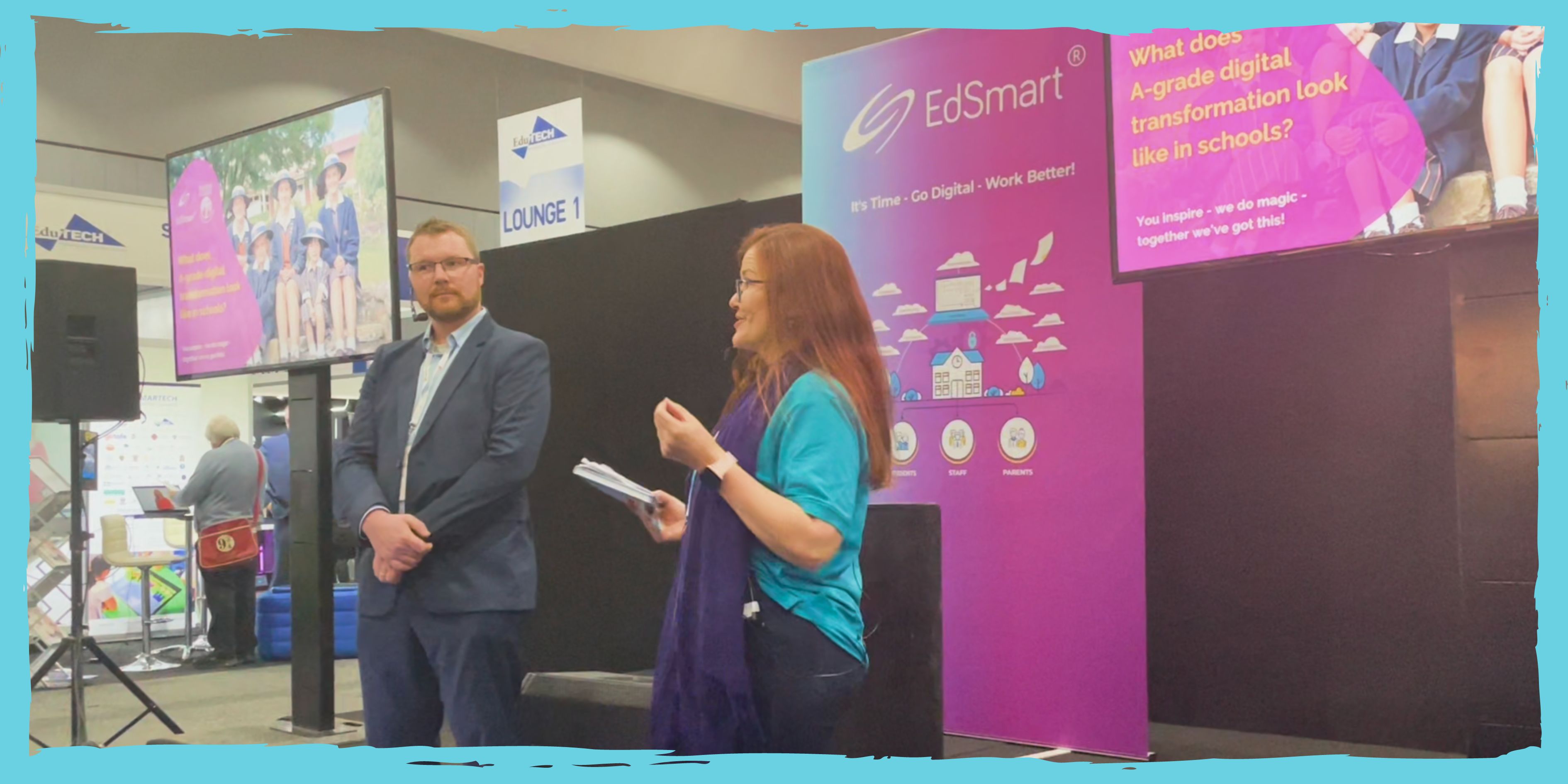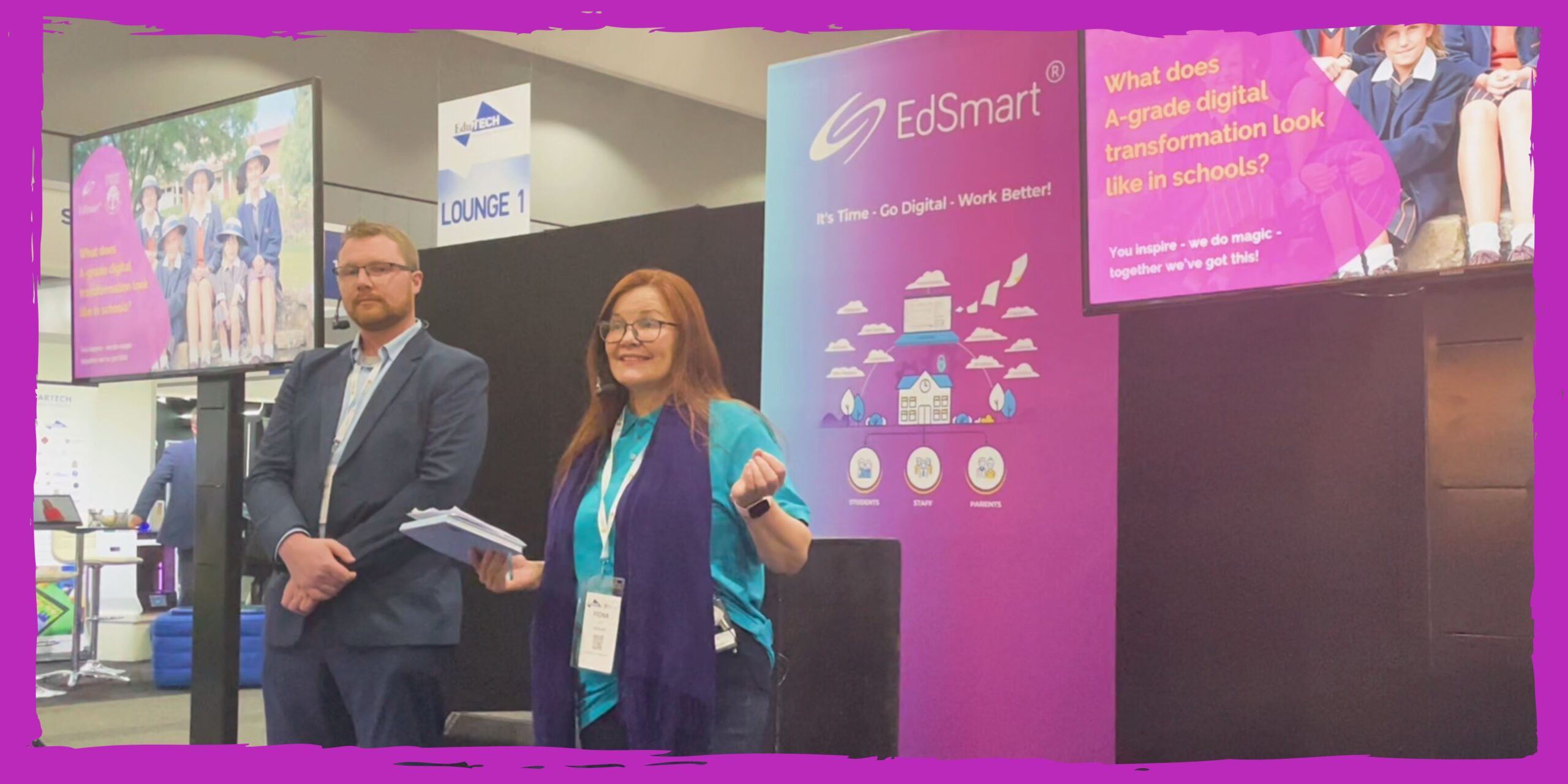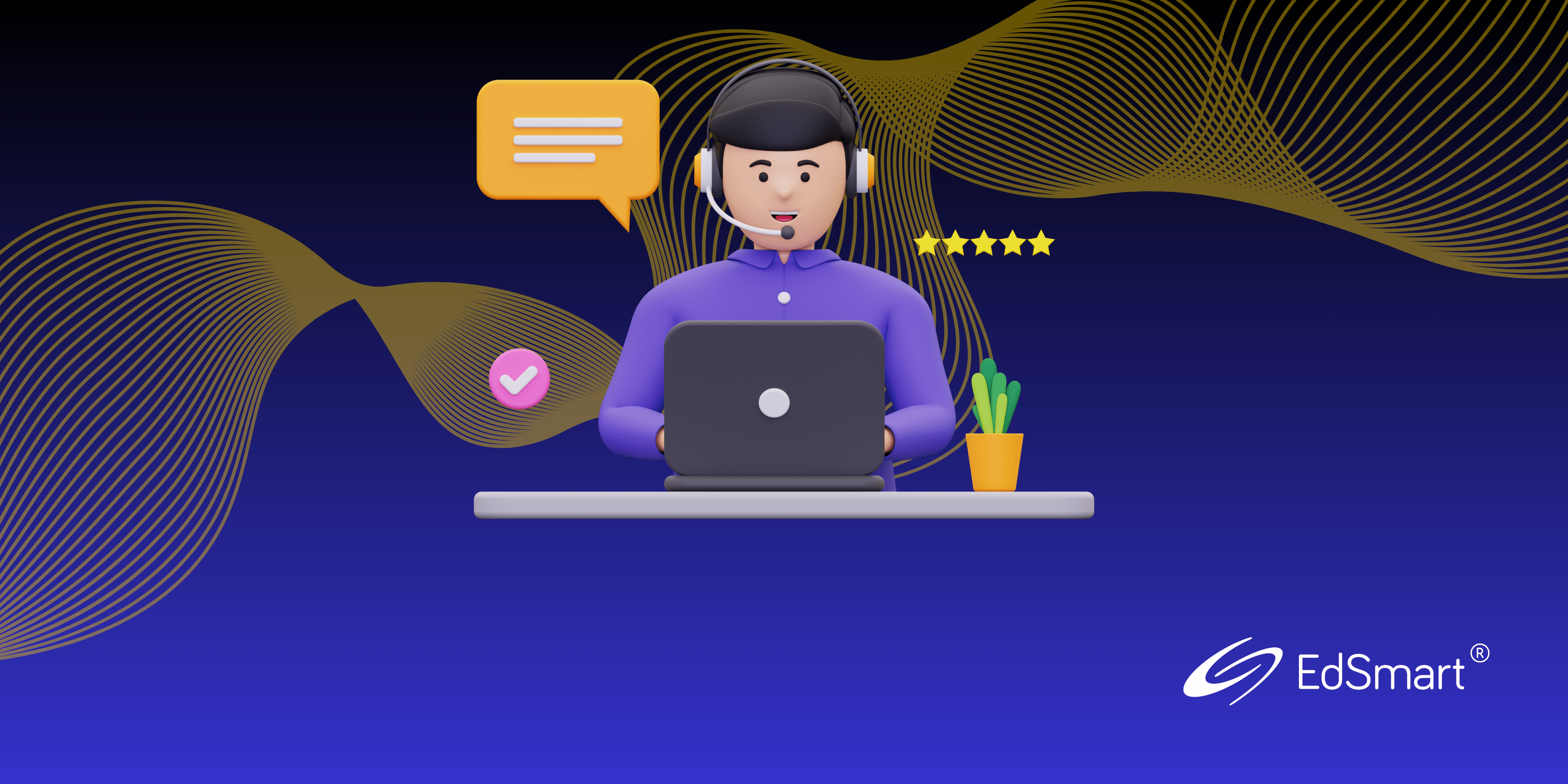At EduTECH 2022, we spoke with Head of ICT at Fahan School Thomas Blackwood about his experiences with digital transformation. This is an edited version of his presentation.
In August 2022, the annual EduTECH Conference took place at the Melbourne Convention and Exhibition Centre (MCEC), Australia, and EdSmart was very proud to contribute to the expo as an exhibitor.
During the event, EdSmart’s Co-Founder and Director – Business Development, Fiona Boyd, discussed ways to successfully manage digital transformation in schools. Thomas Blackwood, Head of ICT at Fahan School in Hobart, Tasmania – a long-standing EdSmart customer – joined her in the discussion.
Fiona and Thomas addressed the finer points of digital transformation in schools: What does it involve? Should you limit the input of staff, students and stakeholders? How do you know when it’s being done ‘right’?
Following is a transcript of their discussion edited for clarity and word length.

Fiona Boyd: Many schools struggle with moving their processes into a digital space, but Fahan School is having quite a lot of success. Thomas, what are some of the things schools need to think about before they start a program of digital transformation?
Thomas Blackwood: “Digital transformation is a big topic. You often hear that it’s coming but the truth is it’s here.”
“A phased approach is something you need to consider carefully to be successful. What I would strongly recommend is having a clear vision of what you’re trying to achieve with your digital transformation and don’t set out to try to change everything all at once. If your goal is to reduce paper usage, don’t set out to eliminate printing completely – maybe just focus on a few key areas. But to be successful, you really need to identify key areas, have a clear objective of what you’re trying to achieve, and flow that through to milestones and targets.”
“A good example is our beginning journey with EdSmart. We quickly identified that having paper slips for all our interactions with students and parents had become unsustainable in the long run. As we wanted to scale as an organisation, the amount of manual handling and work [we had] was not going to scale with our admin staffing employment numbers. So, we needed to do something quickly to keep the quality of interactions with parents and slips, and EdSmart really provided that in a meaningful way to digitise, get away from the paper.”
“As an example, we would have sausage sizzle fundraisers and the teachers and students would be quite excited, but the admin staff were horrified. There would be these big buckets of money coming in, and there’d be 400-plus slips to keep track of, and who was getting what sausage, and all of that had to be counted by multiple people. So, technology and getting [tasks like that] out to a digital space has really enabled us to move forward in other areas.”
What do you do at Fahan School when paving the way for a new EdTech system or a tool that you’ve decided is really going to benefit the school?
“Really understanding the pain-points that your staff or stakeholders are going through. If you’re just starting out on your digital journey, I recommend you talk to your stakeholders, your business leaders, senior leadership, and try to identify pain-points they have, because having their backing is really going to be essential in what you’re trying to achieve.”
“I often meet with various departments within my organisation to see what processes they really struggle with. What are the things that they dread doing when they come to work? Mondays aren’t very pleasant, but is there something they have to do in the middle of the day that they just really, really don’t like to do? And oftentimes, there’s a broken process or a really convoluted workflow behind that.
If we can simplify the process, utilise technology to make it more efficient, that’s what I really thrive [on] and enjoy doing. So, I start by figuring out what’s going to give you the easiest, most beneficial time-savings and go from there; use that as a launching point to build out a digital transformation.”
With COVID, a lot of schools were offered various premium products to digitise in certain ways, and not all experiences have been fruitful. In the rush to not be left behind, how easy – or hard – is it to overlook important steps that contribute to success?
“We see it all the time in discussions with my colleagues. One of the biggest concerns is not including your staff members on this journey.”
“I was talking with a school on the [Australian] mainland about distributing Microsoft Teams as our main communication tool, and they stressed that their executive team was pushing from the top down to really make that happen. It was like staff came in one Monday, and suddenly they just had to start using Teams. They got to the point where the staff kickback was so bad that they actually had to consider rolling back the entire initiative.”
“So, I would stress communicating with your staff, teachers and admin what you’re doing and why you’re doing it. Show them what the benefits are going to be, and bring them along on the journey because, if you don’t, you’re going to be fighting against the tide and it’s going to make your job a lot harder.”
“Often, you’ll find in discussions with them, they might have some feedback that’s totally beneficial to you deploying the set solution. For example, we recently eliminated the use of USB thumb drives on our staff laptops. They’re very popular for just sharing files or getting student homework, but they pose a security risk, and we really wanted them to start utilising the online collaborative spaces like SharePoint and OneDrive as an alternative.”
“In rolling that out and getting feedback from the staff, it was quickly identified that, when there’s end of the year exams, the government mandates that the exams be loaded on USB drives. Certain vendors for foreign languages will ship out a USB with licence files. So, there are definitely things to consider that we have to take on board as part of that rollout whereas, if we had just deployed a blanket ban, there would’ve been a lot of kickback in certain areas, making our life harder. So absolutely bring your staff along for the journey, include them in the conversations — it’s going to make you a lot more successful.”
Thomas, when do you know you’ve got it ‘right’ for something you’ve digitised? What does that look like?
“I’d say the most obvious thing is time-savings. So there’s less handling, there’s less inefficiencies in a process, and maybe less people involved. When you can have computers do big, repetitive tasks for you instead of people, that will be reflected back in the workflows and what your staff are able to do.”
“It’s a real barrier to entry, if you will, the automation, the buzz words, whatever you want to call it, because there is some significant skill required to enter into that space. When I started at Fahan, I didn’t know anything about automation: What tools would I use? Do I go to Microsoft or Amazon? They seem to know what they’re doing. But I just sat down with my technical experts – my systems admin team – discussed what our options were, what tools we were already paying for, and just looked at what we could do within those tools to automate simple things, and that’s where we started.”
“Once we had that basic foundation, automating simple paper processes, or the creation of users within our Windows systems, that then gave us a bit more insight in the collective brain – thinking about what else we could automate. We didn’t start with the big picture stuff, we just took the small steps, which I think is really important. Get your feet wet before jumping in the pool, build up that confidence of what you can and can’t automate, and go from there.

In the world of Australian EdTech, which has pretty much boomed in recent years, what — in your view — is missing? What isn’t there that needs to be?
“I think we would all love just a one-stop solution for IT in schools. I would love to write Microsoft a cheque and just sit back and they handle everything from student sign-ins to broadcast slips to our servers. You name it – it’s just provided by them. The reality is that’s not the case. And, while some vendors will tout that they do everything, they just skim the surface on a lot of products. We’ve found that we’re needing to specialise and go to vendors that do one thing really, really well.”
“As a consequence of that happening, we’re now finding that the integrations aren’t quite as developed as we’d like. As you mature in your digital transformation journey, you’re going to find what used to be paper that’s now automated, you have these really robust workflows, as you go to improve and interconnect even more systems to really just have an end-to-end chain of automation, you’re going to find that, well, this system doesn’t talk to this one natively, so there’s no connector that will make that happen. It breaks up the workflow and you really feel that pain of not having that nice, smooth process.”
“I think we’d like to see more integrations within the educational institutions and companies that can work together, develop some sort of common framework that can be utilised in a common way.”
If you were to give our audience three points to take away that could help them achieve an A-grade digital transformation at their school, what would those three points be?
“The first one is to just start small – don’t bite off more than you can chew. Like I mentioned earlier, when you’re approaching this, it’s going to seem very daunting. There is a significant resource cost in beginning your digital transformation journey, and whether that’s spending time on learning new systems and programming languages to begin automation, or just going out to market and finding a solution that is going to solve the problem that you’re facing, it is an investment, but an investment that does pay dividends over time. If you could save an hour with two staff members a week by digitising some sort of process, after a year that’s 52 hours. So that then can be reinvested into other areas to further automate things.”
“Once you’re doing that enough, you’re really looking at significant time-savings, where instead of just doing manual processes over and over again that are prone to error, you have more time to make your business or environment a better place of learning for students, for your stakeholders.”
Number two – don’t be afraid of technology. You might have gone out to market, some sales person may have offered you some candy and a smooth sales pitch and it didn’t work out for many different reasons. Don’t take that as the be-all, end-all. You’re going to have some failures, and it’s just part of the learning process. So, take that on board, learn from your mistakes and keep trying.”
“The other thing is bring your staff along for the ride — that’s probably the most important one. Communicate with them because, at the end of the day, if you’ve got a mob outside your office that wants to go back to a system that you know is a nightmare, you’re not going to have a good time. So communication is key – communicate why you’re doing what you’re doing, bring them along for the journey and you’ll be successful.”
For more information about Fahan School, visit www.fahan.tas.edu.au
Want to know more about EdSmart? Get in touch with us today!



